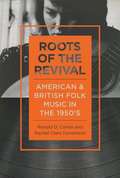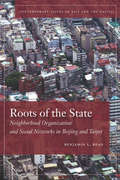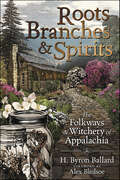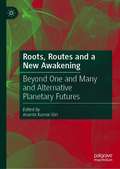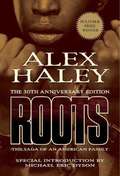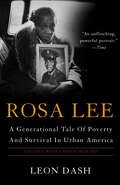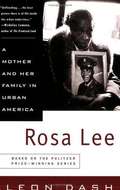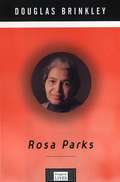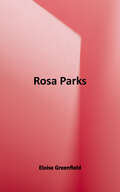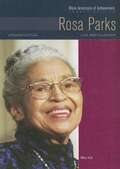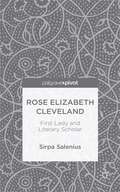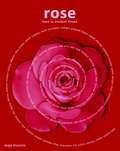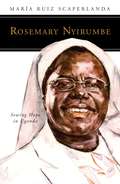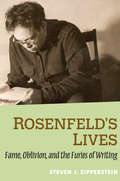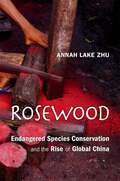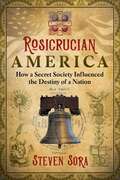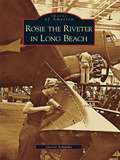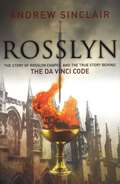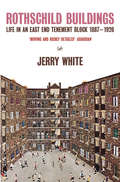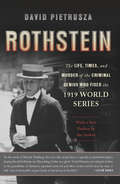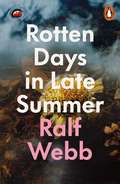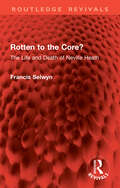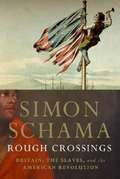- Table View
- List View
Roots of the Revival: American and British Folk Music in the 1950s (Music in American Life)
by Ronald D Cohen Rachel Clare DonaldsonIn Roots of the Revival: American and British Folk Music in the 1950s, Ronald D. Cohen and Rachel Clare Donaldson present a transatlantic history of folk's midcentury resurgence that juxtaposes the related but distinct revivals that took place in the United States and Great Britain. After setting the stage with the work of music collectors in the nineteenth century, the authors explore the so-called recovery of folk music practices and performers by Alan Lomax and others, including journeys to and within the British Isles that allowed artists and folk music advocates to absorb native forms and facilitate the music's transatlantic exchange. Cohen and Donaldson place the musical and cultural connections of the twin revivals within the decade's social and musical milieu and grapple with the performers' leftist political agendas and artistic challenges, including the fierce debates over "authenticity" in practice and repertoire that erupted when artists like Harry Belafonte and the Kingston Trio carried folk into the popular music mainstream. From work songs to skiffle, from the Weavers in Greenwich Village to Burl Ives on the BBC, Roots of the Revival offers a frank and wide-ranging consideration of a time, a movement, and a transformative period in American and British pop culture.
Roots of the State: Neighborhood Organization and Social Networks in Beijing and Taipei
by Benjamin L. ReadMost social science studies of local organizations tend to focus on "civil society" associations, voluntary associations independent from state control, whereas government-sponsored organizations tend to be theorized in totalitarian terms as "mass organizations" or manifestations of state corporatism. Roots of the Stateexamines neighborhood associations in Beijing and Taipei that occupy a unique space that exists between these concepts. Benjamin L. Read views the work of the neighborhood associations he studies as a form of "administrative grassroots engagement. " States sponsor networks of organizations at the most local of levels, and the networks facilitate governance and policing by building personal relationships with members of society. Association leaders serve as the state's designated liaisons within the neighborhood and perform administrative duties covering a wide range of government programs, from welfare to political surveillance. These partly state-controlled entities also provide a range of services to their constituents. Neighborhood associations, as institutions initially created to control societies, may underpin a repressive regime such as China's, but they also can evolve to empower societies, as in Taiwan. This book engages broad and much-discussed questions about governance and political participation in both authoritarian and democratic regimes.
Roots, Branches & Spirits: The Folkways & Witchery of Appalachia
by H. Byron BallardAn Appalachian folklorist “shares with us the rich customs of her forebears, from women's kitchen magic to burial practices to the use of herbs and stones” (Patti Wigington, author of Herb Magic and Badass Ancestors).Natural Magic and Folkways from Those Who Call the Blue Ridge Mountains HomeThe southern Appalachians are rich in folk magic and witchery. This book explores the region's customs and traditions for magical healing, luck, prosperity, scrying, and more. Author H. Byron Ballard—known as the village witch of Asheville—teaches you about the old ways and why they work, from dowsing to communicating with spirits.Learn the deeper meaning of haint blue doors, magic hands for finding, and medicinal herbs and plants. Discover tips for creating tinctures and salves, attuning to the phases of the moon, interpreting omens, and other folkways passed down through the generations. Part cultural journey and part magical guide, this book uncovers the authentic traditions of one of North America's most spiritually vibrant regions“Leave your preconceived notions about Appalachia and its people at the door. Roots, Branches, and Spirits presents a magic born of necessity and skillfully adapted to the place where it was―and still is―practiced.” ―John Beckett, author of The Path of Paganism“Be prepared to be transported as Byron Ballard expertly weaves stories and practice, blending tradition, and modern magical innovation all at once.” ―Laura Tempest Zakroff, author of Weave the Liminal“H. Byron Ballard takes us on another engaging journey into the mountainous rural United States where the worlds of magic, phantoms, and old traditions continue to flourish well into the twenty-first century.” ―Christopher Orapello, coauthor of Besom, Stang & Sword, artist, and cohost of the Down at the Crossroads podcast.
Roots, Routes and a New Awakening: Beyond One and Many and Alternative Planetary Futures
by Ananta Kumar GiriThis book seeks to find creative and transformative relationship among roots and routes and create a new dynamics of awakening so that we can overcome the problems of closed and xenopbhobic roots and rootless cosmopolitanism. The book draws upon multiple philosophical and spiritual traditions of the world such as Siva Tantra, Buddhist phenomenology and Peircean Semiotics and discusses the works of Ibn-Arabi, Thoreau, Tolstoy, Gandhi and Raimon Panikkar,among others.The book is transdiscipinary building on creative thinking from philosophy, anthropology, political studies and literature. It is a unique contribution for forging a new relationship between roots and routes in our contemporary fragile and complex world.
Roots: The Saga Of An American Family
by Alex HaleyOne of the most important books and television series ever to appear, Roots, galvanized the nation, and created an extraordinary political, racial, social and cultural dialogue that hadn't been seen since the publication of Uncle Tom's Cabin. The book sold over one million copies in the first year, and the miniseries was watched by an astonishing 130 million people. It also won both the Pulitzer Prize and the National Book Award. Roots opened up the minds of Americans of all colors and faiths to one of the darkest and most painful parts of America's past. Over the years, both Roots and Alex Haley have attracted controversy, which comes with the territory for trailblazing, iconic books, particularly on the topic of race. Some of the criticism results from whether Roots is fact or fiction and whether Alex Haley confused these two issues, a subject he addresses directly in the book. There is also the fact that Haley was sued for plagiarism when it was discovered that several dozen paragraphs in Roots were taken directly from a novel, The African, by Harold Courlander, who ultimately received a substantial financial settlement at the end of the case. But none of the controversy affects the basic issue. Roots fostered a remarkable dialogue about not just the past, but the then present day 1970s and how America had fared since the days portrayed in Roots.
Rosa Lee: A Generational Tale Of Poverty And Survival In Urban America
by Leon DashBased on a heart-rending and much discussed series in the Washington Post, this is the story of one woman and her family living in the projects in Washington, D. C. A transcendent piece of writing, it won the Pulitzer Prize and the Robert F. Kennedy Journalism Award. For four years Leon Dash of the Washington Post followed the lives of Rosa Lee Cunningham, her children, and five of her grandchildren, in an effort to understand the persistence of poverty and pathology within America’s black underclass. Rosa Lee’s life story spans a half century of hardship in the slums and housing projects of Southeast Washington, a stone’s throw from the marble halls and civic monuments of the world’s most prosperous nation. Yet for all of America’s efforts, Rosa Lee and millions like her remain trapped in a cycle of poverty characterized by illiteracy, teenage pregnancy, drugs, and violent crime. Dash brings us into her life and the lives of her family members offering a human drama that statistics can only refer to. He also shows how some people--including two of Rosa Lee’s children--have made it out of the ghetto, breaking the cycle to lead stable middle-class lives in the mainstream of American society.
Rosa Lee: A Mother And Her Family In Urban America
by Leon DashBased on a series of Pulitzer Prize-winning articles, this harrowing account of life in the urban underclass offers compelling testimony in the ongoing national debate about welfare reform. In Rosa Lee, Washington Post reporter Leon Dash vividly chronicles the hardships and pathologies of the daily life of a family in the slums of Washington, D. C. Defying simplistic conservative and liberal arguments about why the black underclass persists, Dash puts a human face on their struggle to survive despite both disastrous personal choices and almost insurmountable circumstances. The book spans a half-century of hardship, from Rosa Lee Cunningham's bleak early life in the Jim Crow South to her death from AIDS at age fifty-nine. Rosa Lee gave birth to her first child at fourteen, was married at sixteen, and ultimately bore eight children whom she had no legitimate means of supporting. When her welfare checks proved insufficient to feed her family, she turned to prostitution and selling stolen clothes and drugs. Yet Rosa Lee maintained a flickering desire to do what was right. Two of her sons did escape the ghetto to enter mainstream life, and after Dash's series of articles ran in The Washington Post, she made public speeches, hoping to encourage other people to avoid her destructive choices. Rosa Lee is the worthy successor to such works as Jonathan Kozol's Death at an Early Age. It offers no easy answers, but is instead challenging, thought-provoking, and utterly unforgettable.
Rosa Luxemburg
by Jason SchulmanCollection with new contributions to the debate from New Politics concerning the legacy of Rosa Luxemburg. Publishing Stephen Eric Bronner's essay 'Red Dreams and the New Millennium' along with the numerous responses to the piece, a new introduction, and an interview with Bronner stimulates the discussion around Luxemburg's legacy.
Rosa Parks
by Douglas BrinkleyThis book examines an American heroine in the context of the tumultuous time of the Civil Rights movement.
Rosa Parks
by Eloise GreenfieldA chapter book biography for early readers about one of the women who sparked the Civil Rights movement, by legendary author Eloise Greenfield and with illustrations by Gil Ashby. <p><p>When Rosa Parks was growing up in Montgomery, Alabama, she hated the unfair rules that black people had to live by—like drinking out of special water fountains and riding in the back of the bus. Years later, Rosa Parks changed the lives of African American in Montgomery—and all across America—starting with one courageous act. How could one quiet, gentle woman have started it all? This is her story.
Rosa Parks: Civil Rights Leader (Black Americans of Achievement Legacy Edition)
by Dale Evva Gelfand Mary Hull Gloria BlakelyOn December 1, 1955, seamstress Rosa Parks took a stand by refusing to give up her seat on a bus to a white man. Her defiance against an unjust system triggered the Montgomery Bus Boycott and helped spark the civil rights movement in the 1960s. Parks demonstrated the effectiveness of unified peaceful protests, and throughout her life she advocated an end to violence, discrimination, and injustice, eventually establishing the Rosa and Raymond Parks Institute for Self-Development. Rosa Parks, Updated Edition, includes fresh insights on the life and legacy of the woman known as the "mother of the civil rights movement."
Rose Elizabeth Cleveland: First Lady and Literary Scholar
by Sirpa SaleniusRose Elizabeth Cleveland was the First Lady of the United States when she assisted her brother, Grover Cleveland. She was also a literary scholar, novelist, and a poet who published work that empowered women. This book positions Cleveland in the historical context of the early twentieth century, when she helped shape female subjectivity and agency.
Rose: Love in Violent Times
by Inga MuscioWith trademark precision and razor-sharp wit, Inga Muscio explores the impacts of passive violence, abuse, war, and cultural trauma on our most intimate lives in order to uncover a path toward healthy and imaginative sex and love.Rose breaks new ground in answering a fundamental question in most feminist and antiracist writing: how do we identify, witness, and then recover from trauma--as individuals, as families, as communities, and as a country? Muscio's ability to address dire topics with a unique freshness and bravery allows her readers to confront the true brutality of a violent culture, then to react powerfully with righteous rage and hopeful determination.Chilling, eye-opening, and thoroughly enjoyable, Rose offers a fresh and exhilarating perspective on achieving empowerment and self-possession.
Rosemary Nyirumbe: Sewing Hope in Uganda (People of God)
by Maria Ruiz ScaperlandaSister Nyirumbe's 62 years of life provide a powerful testament to God’s presence, love, and hope amidst unimaginable violence. Throughout these many years, her native Uganda and southern Sudan (now South Sudan) have suffered the devastating effects of war and military clashes. Children, as the most vulnerable population, have suffered the most—being orphaned, kidnapped, forced to become child soldiers and sex-slaves. In Rosemary Nyirumbe: Sewing Hope in Uganda, María Ruiz Scaperlanda brings to light Sister Rosemary’s vocation of loving presence to these youth in the midst of this cultural and societal obliteration. As a Sister of the Sacred Heart of Jesus for over 45 years, Sister Rosemary, even at great risk to herself, continues to minister to children enduring the violence around them, teaching practical skills, while helping them to heal, forgive, and hope. Her work taking in girls escaping captivity by Joseph Kony and his Lord’s Resistance Army (LRA) has earned her international recognition. She has been named one of TIME magazine’s "100 Most Influential People in the World."
Rosenfeld's Lives: Fame, Oblivion, and the Furies of Writing
by Steven J. ZippersteinBorn in Chicago in 1918, the prodigiously gifted and erudite Isaac Rosenfeld was anointed a "genius" upon the publication of his "luminescent" novel, Passage from Home and was expected to surpass even his closest friend and rival, Saul Bellow. Yet when felled by a heart attack at the age of thirty-eight, Rosenfeld had published relatively little, his life reduced to a metaphor for literary failure. In this deeply contemplative book, Steven J. Zipperstein seeks to reclaim Rosenfeld's legacy by "opening up" his work. Zipperstein examines for the first time the "small mountain" of unfinished manuscripts the writer left behind, as well as his fiercely candid journals and letters. In the process, Zipperstein unearths a turbulent life that was obsessively grounded in a profound commitment to the ideals of the writing life. Rosenfeld's Lives is a fascinating exploration of literary genius and aspiration and the paradoxical power of literature to elevate and to enslave. It illuminates the cultural and political tensions of post-war America, Jewish intellectual life of the era, and--most poignantly--the struggle at the heart of any writer's life.
Rosewood: Endangered Species Conservation and the Rise of Global China
by Annah Lake ZhuA riveting study of the booming rosewood trade between China and Madagascar uncovers an alternative approach to environmentalism that disrupts Western models. Rosewood is the world’s most trafficked endangered species by value, accounting for larger outlays than ivory, rhino horn, and big cats put together. Nearly all rosewood logs are sent to China, fueling a $26 billion market for classically styled furniture. Vast expeditions across Asia and Africa search for the majestic timber, and legions of Chinese ships sail for Madagascar, where rosewood is purchased straight from the forest. The international response has been to interdict the trade, but in this incisive account Annah Lake Zhu suggests that environmentalists have misunderstood both the intent and the effect of China’s appetite for rosewood, causing social and ecological damage in the process. For one thing, Chinese consumers are understandably seeking to reclaim their cultural heritage, restoring a centuries-old tradition of home furnishing that the Cultural Revolution had condemned. In addition, Chinese firms are investing in environmental preservation. Far from simply exploiting the tree, businesses are carefully managing valuable forests and experimenting with extensive new plantings. This sustainable-use paradigm differs dramatically from the conservation norms preferred by Western-dominated NGOs, whose trade bans have prompted speculation and high prices, even encouraging criminal activity. Meanwhile, attempts to arm conservation task forces—militias meant to guard the forests—have backfired. Drawing on years of fieldwork in China and Madagascar, Rosewood upends the pieties of the global aid industry. Zhu offers a rigorous look at what environmentalism and biodiversity protection might look like in a world no longer dominated by the West.
Rosicrucian America: How a Secret Society Influenced the Destiny of a Nation
by Steven SoraAn in-depth history of Rosicrucianism, its key members, and their roles in the formation and settling of America • Explores Sir Francis Bacon and Dr. John Dee&’s deep influence on England&’s colonization of America as well as the Rosicrucian influence on the Founding Fathers and on cities such as Philadelphia and Williamsburg • Explains how Bacon was the author of many anonymous Rosicrucian texts and how he envisioned America as the &“New Atlantis&” • Reveals the connections of the Order of the Rosy Cross to the Knights of the Golden Circle and to the Georgia Guidestones Dr. John Dee and his polymath protégé Sir Francis Bacon were the most influential men in the court of Queen Elizabeth I, part of an elite group with invisible control throughout Europe. And, as Steven Sora reveals, not only were they key members of the Rosicrucians, they were the driving force behind England&’s colonization of the New World and the eventual establishment of the United States. From Avalon in Newfoundland to New England to Pennsylvania and Virginia, Sora shows how Bacon and Dee&’s Rosicrucian impact is felt throughout North America. He details Bacon&’s possible authorship of the anonymous Rosicrucian texts of the early 1600s, his connections with Sir Walter Raleigh&’s School of Night, and the origins of Rosicrucianism in Bacon&’s Order of the Helmet. He explains how Bacon envisioned America as the New Atlantis, a utopia where liberty and freedom of learning prevailed--a key tenet of the &“Invisible College&” of the Rosicrucian Order--and how Dee convinced the Queen that England had rightful claims in the New World by drawing on legends of both King Arthur and Welsh Prince Madoc voyaging West to America. Sora looks at Rosicrucian influences on the Founding Fathers and earliest settlers of America, such as Washington, Franklin, and William Penn of Pennsylvania, on the American Revolution, and on American colonies, such as the Williamsburg colony. He details how Penn invited Rosicrucians to Philadelphia and how the city&’s layout follows esoteric principles, including a direct reference to Bacon&’s New Atlantis. Moving into the 1800s and beyond, he reveals how a handful of Rosicrucians served as the Inner Sanctum of the Knights of the Golden Circle and how Rosicrucians are behind the Georgia Guidestones, carved granite monoliths with messages in ancient languages. Providing a thorough and expansive view of Rosicrucianism, its occult origins, and its deep imprint on America, Sora shows how this secret society still continues to exert invisible influence on the modern world.
Rosie the Riveter in Long Beach (Images of America)
by Gerrie SchipskeDuring World War II, an unprecedented number of womentook jobs at aircraft plants, shipyards, munitions factories, and other concerns across the nation to produce material essential to winning the war. Affectionately and collectively called "Rosie the Riveter" after a popular 1943 song, thousands of these women came to the U.S. Army-financed Douglas Aircraft Plant in Long Beach, the largest wartime plane manufacturer, to help produce an astonishing number of the aircraft used in the war. They riveted,welded, assembled, and installed, doing man-sized jobs, making attack bombers, other war birds, and cargo transports. They trained at Long Beach City Schools and worked 8- and 10-hour shifts in a windowless, bomb-proof plant. Their children attended Long Beach Day Nursery, and their households ran on rations and victory gardens. When the men came home after the war ended, most of these resilient women lost their jobs.
Rosslyn: The Story of the Rosslyn Chapel and the True Story Behind the Da Vinci Code
by Andrew SinclairThe mysterious history of Rosslyn Chapel and the Knights Templar is revealed in this authoritative volume by a descendent of its first patrons. In the 15th century, William Sinclair, 1st Earl of Caithness and Baron of Roslin, built a Catholic chapel in the Midlothian region of Scotland. Famous for its esoteric symbolism, this flamboyant Gothic church was of great importance to the Knights Templar, who formed a third Temple of Solomon with the patronage of the Sinclair lairds. Historian Andrew Sinclair, whose own family lineage traces back to William, explores the rise and fall of Rosslyn over the course of centuries. It is a tale of religious conflicts and ancient relics, of epic battles and secret societies. Along the way, he dispels the many myths and misinterpretations that have grown up around Rosslyn, as the fortunes of the Sinclair family declined and the Church and Castle fell into ruin.
Roswell: The Ultimate Cold Case
by Thomas J. Carey Donald R. Schmitt“[The authors] have, like each whistleblower before them, paid a price for their . . . amplification of the truth. . . . The most profound event in human history.” —Joseph G. Buchman, Ph.D, moderator for the Citizen Hearing on DisclosureTwo of the world’s leading investigators declare definitively that the Roswell Incident happened and present their closing arguments.For more than seventy years, the crash at Roswell and its ensuing controversies and cover-ups have been investigated. Yet despite continually mounting evidence, there are still disbelievers. Roswell: The Ultimate Cold Case is Carey and Schmitt’s final and commanding word on the case in which they declare victory once and for all.The government has changed their official story on Roswell more than a dozen times, but the witnesses have not recanted. The evidence has not gone away. And won’t go away. The Roswell Incident is the most hotly debated and investigated UFO crash in history with seemingly endless evidence, and eyewitnesses coming forward even years later. Finally, late in life people feel safe enough or feel duty bound to reveal what they know, saw, and heard.Roswell: The Ultimate Cold Case will bring all new exclusive eye witness testimonies to light as well as cover the:Connection of astronauts Edgar Mitchell and Neil Armstrong to Roswell.Connection of Clinton, Carter, Goldwater, Schiff, and Richardson to Roswell.First time artist conception of impact site with craft and bodies based on firsthand testimony.First time full-size model of crash survivor based on eyewitness testimony.And more eyewitness corroboration.“There is no one on this planet who knows more about the Roswell incident than these two guys.” —Larry Landsman, director of special projects for the Syfy Channel
Rothschild Buildings: Life in an East-End Tenement Block 1887 - 1920
by Jerry WhiteWinner of the Jewish Chronicle Harold H. Wingate Literary Award.Rothschild Buildings were typical of the 'model dwellings for the working classes' which were such an important part of the response to late-Victorian London's housing problem. They were built for poor but respectable Jewish immigrants from Eastern Europe, and the community which put down roots there was to be characteristic of the East End Jewish working class in its formative years. By talking to people who grew up in the Buildings in the 1890s and after, and using untapped documentary evidence from a wide range of public and private sources, the author re-creates the richly detailed life of that community and its relations with the economy and culture around it. The book shows how cramped and austere housing was made into homes; how the mechanism of class domination, of which the Buildings were part, was both accepted and fought against; how a close community was riven with constantly shifting tensions; and how that community co-existed in surprising ways with the East End casual poor of 'outcast London'. It provides unique and fascinating insights into immigrant and working-class life at the turn of the last century.
Rothstein: The Life, Times, and Murder of the Criminal Genius Who Fixed the 1919 World Series
by David PietruszaHistory remembers Arnold Rothstein as the man who fixed the 1919 World Series, an underworld genius. The real-life model for The Great Gatsby's Meyer Wolfsheim and Nathan Detroit from Guys and Dolls, Rothstein was much more--and less--than a fixer of baseball games. He was everything that made 1920s Manhattan roar. Featuring Jazz Age Broadway with its thugs, speakeasies, showgirls, political movers and shakers, and stars of the Golden Age of Sports, this is a biography of the man who dominated an age. Arnold Rothstein was a loan shark, pool shark, bookmaker, thief, fence of stolen property, political fixer, Wall Street swindler, labor racketeer, rumrunner, and mastermind of the modern drug trade. Among his monikers were "The Big Bankroll," "The Brain," and "The Man Uptown. " This vivid account of Rothstein's life is also the story of con artists, crooked cops, politicians, gang lords, newsmen, speakeasy owners, gamblers and the like. Finally unraveling the mystery of Rothstein's November 1928 murder in a Times Square hotel room, David Pietrusza has cemented The Big Bankroll's place among the most influential and fascinating legendary American criminals.
Rotten Days in Late Summer
by Ralf WebbA TELEGRAPH AND IRISH TIMES BOOK OF THE YEARLONGLISTED FOR THE POLARI FIRST BOOK PRIZE SHORTLISTED FOR THE FORWARD PRIZE FOR BEST FIRST COLLECTIONSHORTLISTED FOR THE JOHN POLLARD FOUNDATION INTERNATIONAL POETRY PRIZE 'Impressive . . . tender, unflinching' Guardian'This is poetry in the grand tradition of annihiliation by desire. It's what the young are always learning, and the old, if they are wise, never forget' Anne Boyer, author of The Undying'Brilliant . . . heralds the arrival of a frank and vital poetic voice' Sharlene Teo, author of Ponti'Frank and alert . . . an important voice in British poetry' Eley Williams, author of The Liar's Dictionary'Direct and heart-breaking' Alex Dimitrov, author of Love and Other Poems'A rare thing . . . razor-sharp' Julia Copus, author of This Rare Spirit: A Life of Charlotte MewIn Rotten Days in Late Summer, Ralf Webb turns poetry to an examination of the textures of class, youth, adulthood and death in the working communities of the West Country, from mobile home parks, boyish factory workers and saleswomen kept on the road for days at a time, to the yearnings of young love and the complexities of masculinity.Alongside individual poems, three sequences predominate: a series of 'Love Stories', charting a course through the dreams, lies and salt-baked limbs of multiple relationships; 'Diagnostics', which tells the story of the death from cancer of the poet's father; and 'Treetops', a virtuosic long poem weaving together grief and mental health struggles in an attempt to come to terms with the overwhelming data of a life.The world of these poems is close, dangerous, lustrous and difficult: a world in which whole existences are lived in the spin of almost-inescapable fates. In searching for the light within it, this prodigious debut collection announces the arrival of a major new voice in British poetry.
Rotten to the Core?: The Life and Death of Neville Heath (Routledge Revivals)
by Francis SelwynThe Second World War created heroes and scoundrels in good measure. Few men shifted from role to role with the insolent ease of Neville Heath. Exchanging one alias for another, he was at various times Lord ‘Jimmy’ Dudley, Captain Bruce Lockhart, ‘The Cambridge Blue’, Group-Captain Rupert Brooke, and Lieutenant-Colonel James Rupert Cadogan Armstrong, DFC, AFC. In reality Neville Heath was the product of public school and Borstal, an officer and a gentleman dismissed by three armed services and four times convicted in the civilian courts. His final conviction in 1946 was for the most notorious murder of the post-war world.Originally published in 1988, Rotten to the Core? asks who was the real Neville Heath? As Francis Selwyn describes him, the masks he adopted corresponded to a distorted truth. He had been a pilot on active service, but his deeds of heroism were accomplished by log-book forgeries. Yet he was a daredevil, a driver of fast and stolen cars, a would-be cat-burglar, apparently impervious to fear. He lived on the edge of discovery and disgrace, as if exhilarated by the tension. But the escapism of the daydreamer and pilot was allied to a deep inner corruption. With some women who fell for his matinée-idol good looks and debonair charm, he was the perfect gentleman. To some he proved a cold-hearted swindler. With others, he was a sadist who delighted in causing pain. His moral aberration drove him to murder. Neville Heath ended his life on the gallows, playing the officer and gentleman to the last.Francis Selwyn’s tense and vividly written book was a fine successor to Hitler’s Englishman, his biography of William Joyce (Lord Haw-Haw), another misfit from the pre-war world. Rotten to the Core? deals with Heath the psychopath, but it also depicts the curious post-war society which allowed him to take root and to flourish, showing that Heath the confidence trickster – and murderer – was a man of his time.
Rough Crossings: Britain, the Slaves and the American Revolution
by Simon SchamaFor Schama, the neglect of African American experiences -- at the time of the American Revolution -- is particularly regretful because within the fires of that conflict one can locate an important episode in the struggle for black freedom. He describes how African-American slaves by the thousands responded to the British offer of emancipation by escaping from their plantations and making the arduous journey northward to Canada. He also describes how authorities on both sides of the war responded to this phenomenon as they struggled to gain advantage in the war.
